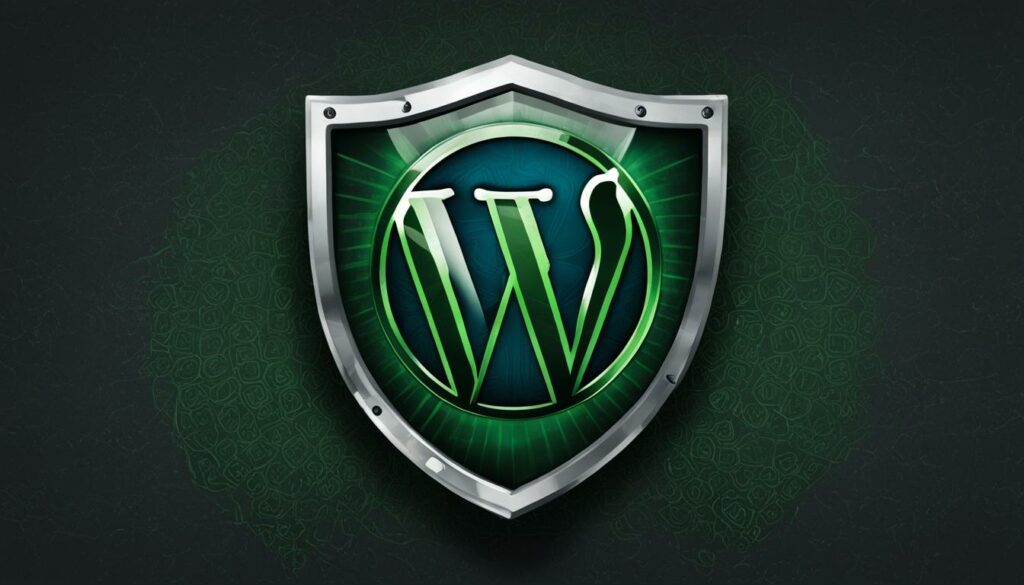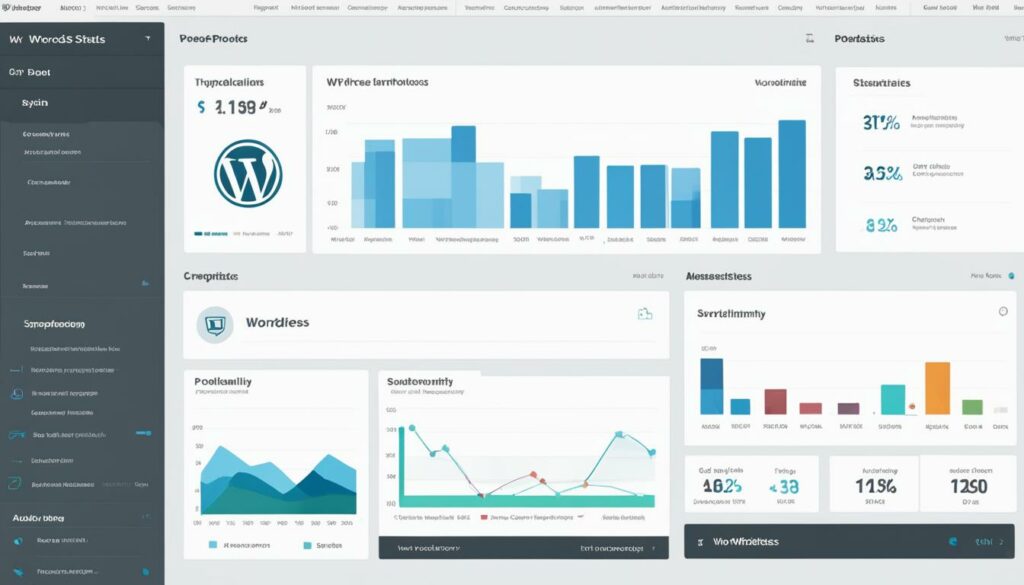Welcome to the world of WordPress security! In today’s digital landscape, protecting your WordPress website from hackers and malware is of utmost importance. With thousands of websites being blacklisted by Google every day due to malicious activities, the need for advanced security measures cannot be overstated.
In this article, we will dive into the realm of advanced techniques to fortify your WordPress site’s security and defend against cyber threats. From WordPress Analytics to analyzing visitor behavior, we’ve got you covered!
Key Takeaways:
- WordPress Analytics provide valuable insights into your website’s performance and visitor behavior.
- Tracking website metrics and analyzing data is crucial for measuring the success of your WordPress site.
- Implementing advanced security measures helps safeguard your WordPress site from hackers and malware.
- Regular updates and maintenance are essential for preserving the integrity of your WordPress site.
- By combining basic security practices with advanced techniques, you can maximize the security of your WordPress site.
Basics of WordPress Security
While WordPress core software is secure, it is essential to take additional steps to enhance website security. This section will cover the basics of WordPress security, including the importance of securing your WordPress site, keeping WordPress updated, and implementing strong password practices.
Securing Your WordPress Site:
Protecting your WordPress site is crucial to prevent unauthorized access and data breaches. Hackers are always looking for vulnerabilities to exploit. By implementing proper security measures, you can minimize the risk of your site being compromised. Here are some key practices to consider:
- Regularly update WordPress core, themes, and plugins to ensure the latest security patches are applied.
- Choose reliable and reputable themes and plugins from trusted sources to avoid potential security vulnerabilities.
- Limit the number of installed plugins to minimize the potential risk of vulnerabilities.
- Use a reputable WordPress security plugin to add an extra layer of protection to your site.
- Configure strong file permissions to restrict unauthorized access to your site’s files and directories.
Keeping WordPress Updated:
Regularly updating WordPress is essential for maintaining a secure website. Updates often include security patches that address vulnerabilities and enhance the overall stability of your site. By keeping your WordPress installation up to date, you can minimize the risk of exploitation by known security threats.
Managing Passwords and User Permissions:
Strong passwords and appropriate user permissions play a significant role in WordPress security. Make sure to:
- Use complex and unique passwords for your WordPress admin account and any other user accounts with administrative privileges.
- Enable two-factor authentication (2FA) for an added layer of security.
- Create strong passwords for all user accounts and regularly update them.
- Limit user permissions to minimize the risk of unauthorized changes or access.
By implementing these basic WordPress security practices, you can significantly reduce the risk of your WordPress site being compromised and ensure the safety of your valuable data.
WordPress Security Best Practices
Implementing WordPress security best practices can further enhance your site’s security. Consider the following recommendations:
| Best Practices | Description |
|---|---|
| Regularly Backup Your Site | Create regular backups of your WordPress site to ensure that you can quickly restore your site in case of any security incidents or data loss. |
| Use a Web Application Firewall (WAF) | A WAF helps protect your site by filtering and blocking malicious traffic before it reaches your WordPress installation. |
| Enable SSL/HTTPS | Securing your site with SSL/HTTPS encrypts the communication between your site and visitors, protecting sensitive data. |
| Limit Login Attempts | Set a limit on the number of login attempts to prevent brute force attacks on your WordPress login page. |
By following these best practices, you can establish a robust security foundation for your WordPress site and minimize the risk of security breaches or unauthorized access.
https://www.youtube.com/watch?v=rfJkfffImgk
The Role of Web Hosting
When it comes to WordPress site security, your choice of web hosting provider is crucial. A good web hosting company offers more than just storage for your website. They play a significant role in ensuring the safety and protection of your WordPress site.
Here’s why your web hosting provider matters:
Continuous Monitoring
A reliable web hosting provider will have systems in place to monitor your WordPress site around the clock. This includes keeping an eye out for any suspicious activities, potential vulnerabilities, and unauthorized access attempts. By detecting and addressing these issues promptly, your hosting company contributes to the overall security of your website.
Protection Against DDoS Attacks
Distributed Denial of Service (DDoS) attacks can disrupt the availability of your WordPress site, causing inconvenience to your visitors and potential damage to your reputation. A reputable web hosting provider will have safeguards in place to mitigate the impact of DDoS attacks. These measures include advanced network infrastructure, traffic filtering, and real-time threat detection.
Regular Updates
Keeping your WordPress site updated is crucial for security. A web hosting provider that prioritizes security will ensure that the server environment and software are regularly updated with the latest security patches. This reduces the risk of vulnerabilities that hackers can exploit to gain unauthorized access to your site.
Disaster Recovery Plans
No one wants to think about the worst-case scenario, but it’s essential to be prepared. A reliable web hosting provider will have well-defined disaster recovery plans in place. These plans outline the steps to be taken in the event of data loss or a security breach. Regular backups and redundancy measures are part of a comprehensive disaster recovery strategy.
Secure Platform for Hosting WordPress Sites
Web hosting companies that prioritize security invest in robust server infrastructure and implement strict security measures. They provide a secure platform where your WordPress site can reside without compromising its security. This includes safeguarding against common security threats, such as malware infections and unauthorized access attempts.
Managed WordPress Hosting
If you want an extra layer of security and convenience, consider managed WordPress hosting. Companies like WPEngine specialize in hosting WordPress sites and offer additional security features tailored for WordPress-specific vulnerabilities. With managed WordPress hosting, you can focus on your website content and leave the security aspects to the experts.
“Choosing a reputable web hosting provider is like having a trustworthy guardian for your WordPress site. By ensuring continuous monitoring, protection against DDoS attacks, regular updates, disaster recovery plans, and a secure platform, a reliable hosting provider can significantly enhance your website security.”

| Hosting Provider | Features | Price |
|---|---|---|
| WPEngine | Managed WordPress hosting, automatic security updates, daily backups, built-in caching | $25/month |
| Bluehost | Shared hosting, free SSL certificate, 24/7 customer support | $2.95/month |
| SiteGround | Managed WordPress hosting, free SSL, daily backups, advanced security | $6.99/month |
When choosing a web hosting provider, prioritize the security features they offer, the reputation of the company, and the level of support they provide. Investing in reliable web hosting gives you peace of mind and lets you focus on growing your WordPress site without worrying about security threats.
WordPress Security in Easy Steps
Securing your WordPress website doesn’t have to be complicated. With a few easy-to-follow steps, you can enhance the security of your WordPress site and protect it from potential threats. In this section, we will walk you through the process of implementing essential WordPress security measures.
Step 1: Install a WordPress Backup Solution
Backing up your WordPress site regularly is crucial for recovering data in the event of a security breach or accidental data loss. Install a reliable WordPress backup plugin, such as UpdraftPlus or BackupBuddy, to automate the backup process and ensure your website’s data is safe.
Step 2: Select a Reliable Security Plugin
WordPress security plugins are essential for detecting and preventing malicious activities on your website. Choose a reputable security plugin, such as Wordfence or Sucuri, that offers features like malware scanning, firewall protection, and login security to safeguard your site.
Step 3: Enable a Web Application Firewall
A web application firewall (WAF) serves as a barrier between your website and potential threats, filtering out malicious traffic and protecting against common web application vulnerabilities. Utilize WAF services like Cloudflare or Sucuri Firewall to add an extra layer of security to your WordPress site.
Step 4: Move Your WordPress Site to SSL/HTTPS
Securing your site with SSL/HTTPS not only protects sensitive information but also enhances your website’s trustworthiness. Obtain an SSL certificate from a trusted Certificate Authority (CA) and configure your WordPress site to use HTTPS. This ensures that data transmitted between your site and its visitors is encrypted and secure.

By following these steps, you’ll significantly improve the security of your WordPress site, reducing the risk of potential vulnerabilities and unauthorized access. Remember to stay proactive and regularly update your WordPress core, themes, and plugins to patch any security loopholes that may arise.
WordPress Security for DIY Users
As a DIY WordPress user, you have the power to implement specific security measures to protect your site from potential threats. By taking a proactive approach to WordPress security, you can safeguard your website and ensure its smooth operation. Here are some essential techniques you can employ:
- Changing the default admin username: By modifying the default admin username, you make it harder for attackers to guess the login credentials and gain unauthorized access to your WordPress site.
- Disabling file editing: By disabling the file editing feature within WordPress, you prevent potential malicious changes to your theme and plugin files, providing an additional layer of protection.
- Disabling PHP file execution: Disabling PHP file execution in certain directories helps prevent hackers from injecting and executing malicious PHP scripts on your server.
- Limiting login attempts: Implementing restrictions on the number of login attempts helps thwart brute force attacks and enhances the security of your WordPress login page.
- Enabling two-factor authentication (2FA): By requiring an additional layer of authentication, such as a code sent to your mobile device, 2FA significantly strengthens the security of your WordPress admin area.
- Changing the WordPress database prefix: Changing the default database prefix in WordPress adds an extra level of security by making it more challenging for attackers to exploit any potential vulnerabilities.
- Password protecting WP-Admin and login pages: Password protecting the WP-Admin and login pages adds an additional layer of security by requiring a separate password for accessing these critical areas of your website.
- Disabling directory indexing and browsing: By disabling directory indexing and browsing, you prevent unauthorized access to directory contents and sensitive files on your server.
- Disabling XML-RPC: Disabling XML-RPC helps block potential attacks and brute force attempts on your WordPress site.
- Automatically logging out idle users: Enabling automatic logouts for idle users helps protect your site in case of unauthorized physical access to a user’s logged-in session.
- Adding security questions to WordPress login: Adding security questions as an additional authentication method during the login process provides an extra layer of security to your WordPress site.
By implementing these security measures, you can significantly reduce the risk of unauthorized access and potential security breaches on your WordPress site. Protecting your website is essential for maintaining its integrity and the trust of your visitors.
Scanning WordPress for Malware and Vulnerabilities
Regularly scanning your WordPress site for malware and vulnerabilities is crucial for maintaining its security and integrity. By detecting and addressing potential threats, you can protect your site from hackers and ensure a safe browsing experience for your visitors. In this section, we will explore the steps involved in scanning WordPress for malware and vulnerabilities, as well as fixing a hacked WordPress site.
Using Security Plugins for Malware Scanning
One effective method to scan your WordPress site for malware is by utilizing security plugins like Sucuri Scanner. These plugins are designed to provide comprehensive scanning capabilities, allowing you to identify any malicious code or files that may have been injected into your site.
“Regularly scanning your WordPress site for malware and vulnerabilities is crucial for maintaining its security and integrity.”
Once you have installed a security plugin, follow the plugin’s instructions to initiate a scanning process. This typically involves running a full website scan, which thoroughly examines all files and directories within your WordPress installation. The plugin will analyze your site’s code and database for any signs of malware or suspicious activities.
During the scanning process, the security plugin will generate a detailed report highlighting any identified malware or vulnerabilities. This report will help you understand the nature of the threat and guide you in taking appropriate actions.
Fixing a Hacked WordPress Site
If your WordPress site has been hacked, it is crucial to take immediate action to restore its security and integrity. Here are the steps you can follow:
- Isolate the affected site: Remove the hacked site from your web server and place it in a separate directory for analysis and recovery.
- Identify and remove malicious files: Using the information provided by the security plugin’s report, locate and remove any malicious files or code injected into your site.
- Update WordPress and plugins: Ensure that your WordPress core and all installed plugins are up to date. This will help patch any known vulnerabilities and strengthen your site’s security.
- Change passwords: Reset passwords for all user accounts, including administrators, to prevent unauthorized access to your site.
- Scan for remaining threats: Run a thorough scan of your site again to ensure that all malware has been successfully removed.
- Implement preventive measures: Take proactive steps to enhance your site’s security, such as installing a reliable security plugin, enabling two-factor authentication, and regularly backing up your site.
By following these steps, you can effectively fix a hacked WordPress site and safeguard it against future security breaches.
Remember to perform regular scans and stay vigilant to keep your WordPress site secure. By taking these proactive measures, you can protect your site’s reputation, maintain visitor trust, and ensure a secure online presence.
Importance of WordPress Analytics for Security
When it comes to maintaining the security of your WordPress website, tracking and analyzing website performance is of utmost importance. WordPress Analytics provides valuable insights that can help you measure the success of your website and make informed decisions to enhance its security.
By utilizing WordPress data analysis and site metrics, you can keep a close eye on your website’s traffic patterns and visitor behavior. This allows you to identify and address any potential security vulnerabilities or suspicious activities.
WordPress traffic analysis provides valuable information on the sources of your website traffic, whether it’s from organic search, social media, or referral links. Understanding where your visitors are coming from helps you identify any unusual traffic patterns that may indicate malicious intent.
One of the key benefits of monitoring WordPress site statistics is the ability to analyze visitor behavior. By tracking actions such as page views, click-through rates, and conversion rates, you can gain insights into the effectiveness of your website security measures. This information allows you to optimize your security strategies and protect your website from potential threats.
Additionally, WordPress data tracking enables you to identify any sudden spikes or drops in website performance, which could be a sign of a security breach or hacking attempt. By closely monitoring these performance metrics, you can take immediate action and strengthen your website’s defenses.
“Analyzing website performance and visitor behavior through WordPress Analytics is like having your own security camera system. It helps you detect and anticipate potential security threats, allowing you to safeguard your website effectively.”
To illustrate the importance of WordPress Analytics for security, consider the following scenario:
| Scenario | Impact |
|---|---|
| Your website experiences a sudden increase in traffic from an unknown source. | This could indicate the presence of botnets or malicious bot traffic attempting to exploit vulnerabilities in your website’s security. |
| There is a significant drop in your website’s conversion rate. | This may suggest that visitors are encountering obstacles or suspicious activities, potentially due to security breaches. |
| Your website’s pages load significantly slower than usual. | This could be a sign of a distributed denial-of-service (DDoS) attack or server overload, both of which pose security risks. |
By regularly analyzing these WordPress site metrics and taking appropriate measures, you can proactively protect your website from security threats and ensure its long-term integrity. Implementing robust security measures alongside WordPress Analytics can help you stay one step ahead of potential attackers and keep your website secure.

Implementing Advanced Security Measures
When it comes to WordPress security, implementing advanced measures is crucial to safeguard your website against potential threats. By incorporating these techniques, you can fortify your WordPress site and ensure the protection of sensitive data and user information.
Let’s explore some essential advanced security measures:
1. WordPress Firewall
Installing a firewall is a proactive step to defend your website against malicious attacks. A reliable WordPress firewall plugin, such as Wordfence or Sucuri, can detect and block potential threats before they can exploit any vulnerabilities in your website’s code.
2. Changing Login Page URL
By changing the default login page URL, you can effectively deter hackers trying to gain unauthorized access to your WordPress site. A plugin like WPS Hide Login allows you to easily modify the login page URL, making it more challenging for attackers to guess.
3. JavaScript Challenge for Login Page
Implementing a JavaScript challenge for the login page adds an additional layer of security. By requiring visitors to solve a simple challenge, such as dragging and dropping puzzle pieces, you can ensure that automated bots or brute-force attacks are unable to breach your login page.
4. Comment Section Security
The comment section of your WordPress site can be vulnerable to spam and malicious code injections. By enabling automated spam detection plugins, such as Akismet, and implementing strong moderation policies, you can prevent unauthorized comments and protect your website’s integrity.
5. Minimizing Plugins
While plugins provide additional functionality to your WordPress site, using too many can increase the risk of security vulnerabilities. Minimize the number of plugins you install by regularly reviewing and uninstalling unnecessary ones, reducing the potential attack surface.
6. Utilizing Auto-Updates
Keeping your WordPress core, themes, and plugins up to date is vital for maintaining security. Enable auto-updates for your WordPress installation and plugins to ensure that you have the latest security patches and bug fixes.
7. Checking Open Ports on the Server
Regularly scan your server for open ports to identify any potential entry points for hackers. Utilize port scanning tools like Nmap to check for vulnerabilities and close any unnecessary open ports to reduce the risk of unauthorized access.
8. Setting Up SSL Properly
Setting up Secure Sockets Layer (SSL) properly is essential to protect sensitive data transmitted between your website and users’ browsers. Obtain an SSL certificate from a trusted certificate authority (CA) and configure it correctly to enable secure HTTPS connections.
9. Adding Security Headers
Implementing security headers, such as Content Security Policy (CSP) and Strict-Transport-Security (HSTS), can enhance your website’s security posture. These headers provide an additional layer of protection by mitigating common security risks, such as cross-site scripting (XSS) and man-in-the-middle (MITM) attacks.
10. Daily Backups and Running Security Tests
Regularly backing up your WordPress website is crucial in case of data loss or security incidents. Set up automated daily backups using plugins like UpdraftPlus or BackupBuddy. Additionally, running regular security tests using tools like Sucuri SiteCheck or WPScan can help identify and fix any security vulnerabilities.
By implementing these advanced security measures, you can significantly enhance the security of your WordPress site and minimize the risk of potential attacks or data breaches.
| WordPress Security Measure | Description |
|---|---|
| WordPress Firewall | Installing a firewall plugin to detect and block malicious attacks. |
| Changing Login Page URL | Modifying the default login page URL to thwart unauthorized access attempts. |
| JavaScript Challenge for Login Page | Implementing a JavaScript challenge to protect against brute-force attacks. |
| Comment Section Security | Enabling spam detection plugins and implementing strong moderation policies. |
| Minimizing Plugins | Reducing the number of installed plugins to minimize security vulnerabilities. |
| Utilizing Auto-Updates | Enabling automated updates for WordPress core, themes, and plugins. |
| Checking Open Ports on the Server | Scanning for open ports and closing unnecessary ones to prevent unauthorized access. |
| Setting Up SSL Properly | Obtaining and configuring an SSL certificate for secure HTTPS connections. |
| Adding Security Headers | Implementing security headers to mitigate common security risks. |
| Daily Backups | Setting up automated daily backups to ensure quick recovery in case of incidents. |
| Running Security Tests | Performing regular security tests to identify and address vulnerabilities. |
Importance of Regular Updates and Maintenance
Regular updates and maintenance play a crucial role in maintaining the security of your WordPress website. By keeping your WordPress core, plugins, and themes up to date, you ensure that the latest security patches are applied, minimizing the risk of vulnerabilities.
Updating WordPress core is essential as it not only provides new features but also addresses any security issues that may have been discovered. Developers constantly work to improve the security of WordPress, and by staying up to date with the latest updates, you benefit from these improvements.
Plugin updates are equally important. Outdated plugins can be targeted by hackers, potentially compromising the security of your website. By regularly updating your plugins, you ensure that any security vulnerabilities are patched, reducing the risk of exploitation.
Theme updates also contribute to maintaining WordPress security. Themes often include various functionalities that can affect the overall security of your website. By updating your themes, you ensure that any security weaknesses are addressed, providing a more secure environment for your WordPress site.
In addition to updates, regular maintenance is vital for WordPress security. Conducting routine maintenance tasks such as database optimization and file cleanup helps to keep your website running smoothly and reduces the risk of security incidents.
Regular maintenance also includes monitoring your website for any unusual activities or suspicious behavior. By keeping a vigilant eye on your website, you can quickly identify and address any security concerns before they escalate.
Remember, maintaining WordPress security is an ongoing process. Regularly updating your WordPress core, plugins, and themes, along with performing routine maintenance tasks, ensures that your website remains secure against evolving threats. By prioritizing regular updates and maintenance, you protect your website and the sensitive information it holds.
Conclusion
Maximizing WordPress security is crucial to protect your website against hackers and malware. In this article, we have provided an overview of essential security measures that can significantly enhance the security and integrity of your WordPress site.
By combining basic techniques like keeping WordPress updated, managing passwords, and selecting a reliable web hosting provider with advanced measures such as implementing security plugins, enabling a web application firewall, and regularly scanning for malware, you can create a robust defense against potential threats.
Remember that security is an ongoing process. Regularly monitoring and updating your WordPress site are crucial to staying one step ahead of hackers. Be sure to keep an eye on WordPress security trends, implement the latest security measures, and conduct routine audits to address any new vulnerabilities.
By following these techniques and adopting a proactive approach to WordPress security, you can protect your site, maintain the trust of your users, and ensure the smooth functioning of your online presence.
FAQ
Q: Why is WordPress security important?
A: WordPress security is crucial because thousands of websites are blacklisted by Google daily for malware and phishing. Enhancing security can protect your site from hackers and malware.
Q: How can I improve WordPress security?
A: To improve WordPress security, you should keep your WordPress software updated, manage passwords and user permissions, choose a reliable web hosting provider, and implement security measures like backup solutions, security plugins, and SSL/HTTPS.
Q: What role does web hosting play in WordPress security?
A: Web hosting plays a significant role in WordPress security. A good web hosting company provides continuous monitoring, protection against DDoS attacks, regular updates, disaster recovery plans, and a secure platform for hosting WordPress sites. Managed WordPress hosting providers offer additional security features.
Q: What are some easy steps to enhance WordPress security?
A: Some easy steps to enhance WordPress security include installing a WordPress backup solution, using a reliable security plugin, enabling a web application firewall, and securing your site with SSL/HTTPS.
Q: What security measures can DIY WordPress users implement?
A: DIY WordPress users can implement various security measures, such as changing the default admin username, disabling file editing and PHP file execution, limiting login attempts, enabling two-factor authentication, changing the WordPress database prefix, password protecting WP-Admin and login pages, disabling directory indexing and browsing, disabling XML-RPC, automatically logging out idle users, and adding security questions to the WordPress login page.
Q: How can I scan my WordPress site for malware and vulnerabilities?
A: You can scan your WordPress site for malware and vulnerabilities using security plugins like Sucuri Scanner. These plugins help detect malware and provide steps to fix a hacked WordPress site.
Q: How can WordPress Analytics contribute to website security?
A: WordPress Analytics helps track website performance, measure website success, and analyze visitor behavior. By utilizing WordPress site metrics, traffic analysis, and site statistics, you can gain insights that can enhance your site’s security.
Q: What are some advanced security measures for WordPress?
A: Advanced security measures for WordPress include implementing a firewall, changing the login page URL, adding a JavaScript challenge for the login page, securing the comment section, minimizing plugin usage, utilizing auto-updates, checking open ports on the server, setting up SSL properly, adding security headers, setting up daily backups, and running final security tests.
Q: How important are regular updates and maintenance for WordPress security?
A: Regular updates and maintenance are essential for maintaining WordPress security. It is crucial to update WordPress core, plugins, and themes to ensure the latest security patches are applied. Ongoing maintenance addresses new vulnerabilities and security concerns that may arise.












